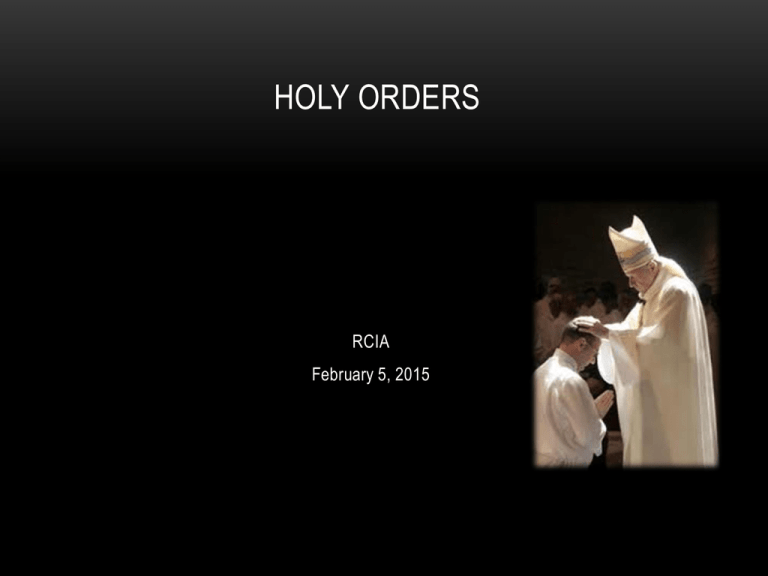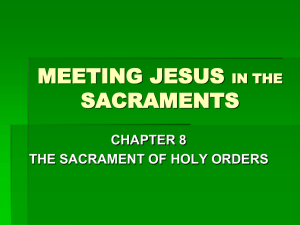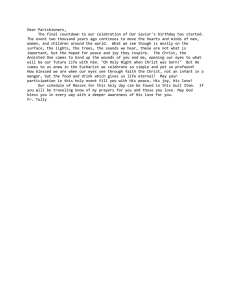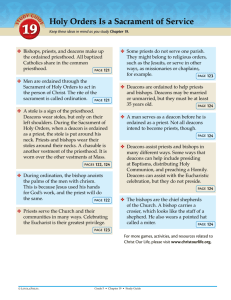RCIA Sacrament of Holy Orders 2-5
advertisement

HOLY ORDERS RCIA February 5, 2015 • Holy Orders is the sacrament through which the mission entrusted by Christ to his apostles continues to be exercised in the Church until the end of time. • It is the sacrament of apostolic ministry. It includes three degrees: Episcopate (bishop), Presbyterate (priest), and Diaconate (deacon). Why is this Sacrament called “Orders”? • The word order in Roman antiquity (Ordo) designated an established civil body, especially a governing body. • Ordinatio (ordination) means incorporation into an ordo. • In the Church there are established bodies which Tradition, along with a basis in Sacred Scripture, has since ancient times called “orders.” (Heb 5:6; 7:11; Ps 110:4) • Today the word "ordination" is reserved for the sacramental act which integrates a man into the order of bishops, priests, or deacons for it confers a gift of the Holy Spirit that permits the exercise of a "sacred power" which can come only from Christ himself through his Church. • Ordination is also called consecratio, for it is a setting apart by Christ himself for his Church. • The laying on of hands by the bishop, with the prayer of consecration, constitutes the visible sign of this sacrament. The Priesthood of the Old Covenant The chosen people was constituted by God as "a kingdom of priests and a holy nation." But within the people of Israel, God chose one of the twelve tribes, that of Levi, and set it apart for liturgical service. The priests were "appointed to act on behalf of men in relation to God, to offer gifts and sacrifices for sins.“ Instituted to proclaim the Word of God and to restore communion with God by sacrifices and prayer, this priesthood nevertheless remained powerless to bring about salvation, needing to repeat its sacrifices ceaselessly and being unable to achieve a definitive sanctification, which only the sacrifice of Christ would accomplish. Priesthood of Old Covenant • The liturgy of the Church, however, sees in the priesthood of Aaron and the service of the Levites a prefiguring of the ordained ministry of the New Covenant. • Everything that the priesthood of the Old Covenant prefigured finds its fulfillment in Christ Jesus, the "one mediator between God and men.“ • The Christian tradition considers Melchizedek, "priest of God Most High," as a prefiguration of the priesthood of Christ, the unique "high priest after the order of Melchizedek";1 "holy, blameless, unstained,”2 "by a single offering he has perfected for all time those who are sanctified,”3 that is, by the unique sacrifice of the cross. 2 Tim 2:5.16 Heb 5:10; cf. 6:20; Gen 14:18. Heb 7:26 Baptismal Priesthood Through baptism we are considered heirs to the Kingdom of God, we become part of a royal priesthood and sharers in the prophetic, priestly and kingly dignity of Christ. Preaching the gospel to the world as a prophet, serving the needy in the world as king, and offering prayer and sacrifice for the world as priest. Through our common priesthood we can be active participants in the sacrifice that is re created at every Mass The ministerial or hierarchical priesthood of bishops and priests, and the common priesthood of all the faithful participate, "each in its own proper way, in the one priesthood of Christ." However, they differ essentially. While the common priesthood of the faithful is exercised by the unfolding of baptismal grace --a life of faith, hope, and charity, a life according to the Spirit--, the ministerial priesthood is at the service of the common priesthood. It is directed at the unfolding of the baptismal grace of all Christians. The ministerial priesthood is a means by which Christ unceasingly builds up and leads his Church. Ordained Priesthood In the ecclesial service of the ordained minister, it is Christ himself who is present to his Church as Head of his Body, Shepherd of his flock, high priest of the redemptive sacrifice, Teacher of Truth. This is what the Church means by saying that the priest, by virtue of the sacrament of Holy Orders, acts “in persona Christi Capitis” This presence of Christ in the minister is not to be understood as if the latter were preserved from all human weaknesses, the spirit of domination, error, even sin. Ordained Priesthood and Service The power of the Holy Spirit does not guarantee all acts of ministers in the same way. While this guarantee extends to the sacraments, so that even the minister's sin cannot impede the fruit of grace, in many other acts the minister leaves human traces that are not always signs of fidelity to the Gospel and consequently can harm the apostolic fruitfulness of the Church. (CCC 1550) This priesthood is ministerial. "That office . . . which the Lord committed to the pastors of his people, is in the strict sense of the term a service." The sacrament of Holy Orders communicates a "sacred power" which is none other than that of Christ. The exercise of this authority must therefore be measured against the model of Christ, who by love made himself the least and the servant of all. • The divinely instituted ecclesiastical ministry is exercised in different degrees by those who even from ancient times have been called bishops, priests, and deacons.“ • Catholic doctrine, expressed in the liturgy, the Magisterium, and the constant practice of the Church, recognizes that there are two degrees of ministerial participation in the priesthood of Christ: the episcopacy and the presbyterate . • The diaconate is intended to help and serve them. • Catholic doctrine teaches that the degrees of priestly participation (episcopate and presbyterate) and the degree of service (diaconate) are all three conferred by a sacramental act called "ordination," that is, by the sacrament of Holy Orders Episcopal Ordination • Amongst the various offices which have been exercised in the Church from the earliest times the chief office, according to the witness of tradition, is held by the function of the bishops, and in virtue consequently of the unbroken succession going back to the beginning, are regarded as transmitters of the apostolic line. • To fulfill their mission, "the apostles were endowed by Christ with a special outpouring of the Holy Spirit coming upon them, and by the imposition of hands they passed on to their auxiliaries the gift of the Spirit, which is transmitted down to our day through episcopal consecration." Episcopal Ordination • "Episcopal consecration confers, together with the office of sanctifying, also the offices of teaching and ruling. . . . In fact . . . by the imposition of hands and through the words of the consecration, the grace of the Holy Spirit is given, and a sacred character is impressed such that bishops, in an eminent and visible manner, take the place of Christ himself, teacher, shepherd, and priest, and act as his representative • "By virtue, therefore, of the Holy Spirit who has been given to them, bishops have been constituted true and authentic teachers of the faith and have been made pontiffs and pastors." Ordination of Bishops • In our day, the lawful ordination of a bishop requires a special intervention of the Bishop of Rome, because he is the supreme visible bond of the communion of the particular Churches in the one Church and the guarantor of their freedom. • As Christ's vicar, each bishop has the pastoral care of the particular Church entrusted to him, but at the same time he bears collegially with all his brothers in the episcopacy the solicitude for all the Churches " The Ordination of Priests – Co-workers of the Bishops • "The function of the bishops' ministry was handed over in a subordinate degree to priests so that they might be appointed in the order of the priesthood and be co-workers of the episcopal order for the proper fulfillment of the apostolic mission that had been entrusted to it by Christ.“ • "Because it is joined with the episcopal order the office of priests shares in the authority by which Christ himself builds up and sanctifies and rules his Body. • Through that sacrament priests by the anointing of the Holy Spirit are signed with a special character and so are configured to Christ the priest in such a way that they are able to act in the person of Christ the head." • The priests are consecrated in order to preach the Gospel and shepherd the faithful as well as to celebrate divine worship as true priests of the New Testament.“ • It is in the celebration of the Eucharist that they exercise in a supreme degree their sacred office; there, acting in the person of Christ and proclaiming his mystery, they unite the offerings of the faithful to the sacrifice of Christ their head, and in the sacrifice of the Mass they make present again and apply, until the coming of the Lord, the unique sacrifice of the New Testament, that namely of Christ offering himself once for all a spotless victim to the Father." The Ordination of Deacons – "in order to serve" • At a lower level of the hierarchy are to be found deacons, who receive the imposition of hands 'not unto the priesthood, but unto the ministry.’ • At an ordination to the diaconate only the bishop lays hands on the candidate, thus signifying the deacon's special attachment to the bishop in the tasks of his "diakonia.“ Transitional versus Permanent • Transitional Deacon Called to the priesthood Ordained as transitional deacon last year of seminary Following year will be ordained into the priesthood* Celibate • Permanent Deacon Called to the permanent diaconate May be married If wife should die, cannot remarry Could possible be called to priesthood dependent upon numerous factors Permanent Diaconate • The sacrament of Holy Orders marks them with an imprint ("character") which cannot be removed and which configures them to Christ, who made himself the "deacon" or servant of all. • Among other tasks, it is the task of deacons to assist the bishop and priests in the celebration of the divine mysteries, above all the Eucharist, in the distribution of Holy Communion, in assisting at and blessing marriages, in the proclamation of the Gospel and preaching, in presiding over funerals, and in dedicating themselves to the various ministries of charity. THE CELEBRATION OF THIS SACRAMENT • Given the importance that the ordination of a bishop, a priest, or a deacon has for the life of the particular Church, its celebration calls for as many of the faithful as possible to take part. • It should take place preferably on Sunday, in the cathedral, with solemnity appropriate to the occasion. • All three ordinations, of the bishop, of the priest, and of the deacon, follow the same movement. Their proper place is within the Eucharistic liturgy. • The essential rite of the sacrament of Holy Orders for all three degrees consists in the bishop's imposition of hands on the head of the ordinand and in the bishop's specific consecratory prayer asking God for the outpouring of the Holy Spirit and his gifts proper to the ministry to which the candidate is being ordained. Who Can Confer This Sacrament? • Christ himself chose the apostles and gave them a share in his mission and authority. Raised to the Father's right hand, he has not forsaken his flock but he keeps it under his constant protection through the apostles, and guides it still through these same pastors who continue his work today. Thus, it is Christ whose gift it is that some be apostles, others pastors. He continues to act through the bishops. • Since the sacrament of Holy Orders is the sacrament of the apostolic ministry, it is for the bishops as the successors of the apostles to hand on the "gift of the Spirit," the "apostolic line." • Validly ordained bishops, i.e., those who are in the line of apostolic succession, validly confer the three degrees of the sacrament of Holy Orders. Who can receive this sacrament? "Only a baptized man validly receives sacred ordination." The Lord Jesus chose men to form the college of the twelve apostles, and the apostles did the same when they chose collaborators to succeed them in their ministry. The college of bishops, with whom the priests are united in the priesthood, makes the college of the twelve an ever-present and ever-active reality until Christ's return. The Church recognizes herself to be bound by this choice made by the Lord himself. For this reason the ordination of women is not possible. (CCC 1577) No one has a right to receive the sacrament of Holy Orders. Indeed no one claims this office for himself; he is called to it by God. Anyone who thinks he recognizes the signs of God's call to the ordained ministry must humbly submit his desire to the authority of the Church, who has the responsibility and right to call someone to receive orders. The effects of the sacrament of holy orders • This sacrament configures the recipient to Christ by a special grace of the Holy Spirit, so that he may serve as Christ's instrument for his Church. • By ordination one is enabled to act as a representative of Christ, Head of the Church, in his triple office of priest, prophet, and king. • As in the case of Baptism and Confirmation this share in Christ's office is granted once for all. The sacrament of Holy Orders, like the other two, confers an indelible spiritual character and cannot be repeated or conferred temporarily. • Since it is ultimately Christ who acts and effects salvation through the ordained minister, the unworthiness of the latter does not prevent Christ from acting. Summary • 1591 The whole Church is a priestly people. Through Baptism all the faithful share in the priesthood of Christ. This participation is called the "common priesthood of the faithful." Based on this common priesthood and ordered to its service, there exists another participation in the mission of Christ: the ministry conferred by the sacrament of Holy Orders, where the task is to serve in the name and in the person of Christ the Head in the midst of the community. • 1592 The ministerial priesthood differs in essence from the common priesthood of the faithful because it confers a sacred power for the service of the faithful. The ordained ministers exercise their service for the People of God by teaching (munus docendi), divine worship (munus liturgicum) and pastoral governance (munus regendi). • 1593 Since the beginning, the ordained ministry has been conferred and exercised in three degrees: that of bishops, that of presbyters, and that of deacons. • 1594 The bishop receives the fullness of the sacrament of Holy Orders, which integrates him into the episcopal college and makes him the visible head of the particular Church entrusted to him. As successors of the apostles and members of the college, the bishops share in the apostolic responsibility and mission of the whole Church under the authority of the Pope, successor of St. Peter. • 1595 Priests are united with the bishops in sacerdotal dignity and at the same time depend on them in the exercise of their pastoral functions; they are called to be the bishops' prudent co workers. They receive from the bishop the charge of a parish community or a determinate ecclesial office. • 1596 Deacons are ministers ordained for tasks of service of the Church; they do not receive the ministerial priesthood, but ordination confers on them important functions in the ministry of the word, divine worship, pastoral governance, and the service of charity, tasks which they must carry out under the pastoral authority of their bishop. • 1597 The sacrament of Holy Orders is conferred by the laying on of hands followed by a solemn prayer of consecration asking God to grant the ordinand the graces of the Holy Spirit required for his ministry. Ordination imprints an indelible sacramental character. • 1598 The Church confers the sacrament of Holy Orders only on baptized men, whose suitability for the exercise of the ministry has been duly recognized. Church authority alone has the responsibility and right to call someone to receive the sacrament of Holy Orders. • 1599 In the Latin Church the sacrament of Holy Orders for the presbyterate is normally conferred only on candidates who are ready to embrace celibacy freely and who publicly manifest their intention of staying celibate for the love of God's kingdom and the service of men. • 1600 It is bishops who confer the sacrament of Holy Orders in the three degrees.





